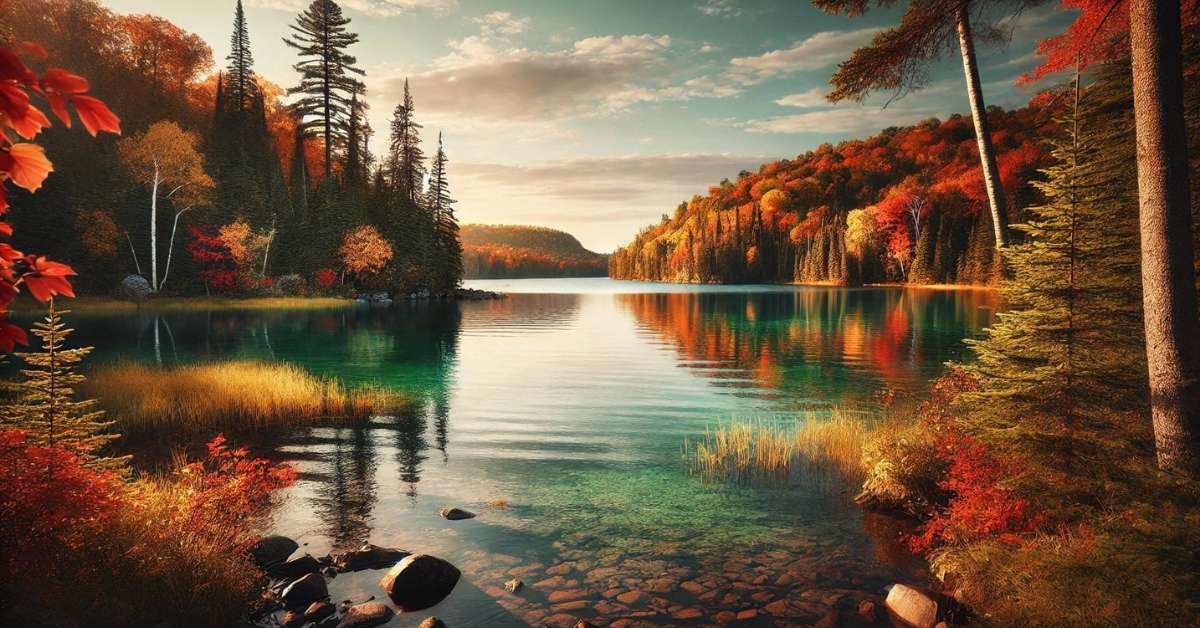Introduction
Square Lake, located in Washington County, Minnesota, is a unique freshwater body renowned for its clarity, pristine surroundings, and ecological importance. Unlike many of the well-known lakes in Minnesota, Square Lake is a relatively small yet environmentally significant body of water. Its high-quality water and surrounding habitats have made it a favorite for recreational activities like swimming, fishing, and diving, while its ecological role in the region contributes to the biodiversity and health of the local environment.
This article will explore Square Lake’s environmental niche, focusing on its geographical characteristics, water quality, ecosystems, and the ways in which human activities and natural forces influence this remarkable lake. Understanding the environmental role of Square Lake is crucial to preserving its ecological integrity and ensuring that future generations can continue to enjoy its natural beauty.
1. Geographic and Hydrological Features of Square Lake
Square Lake is situated in the northeastern part of Washington County, approximately 25 miles northeast of the Twin Cities in Minnesota. Despite its name, Square Lake is not perfectly square but rather irregularly shaped, covering around 220 acres, with a maximum depth of 68 feet. This deep lake is primarily spring-fed, which contributes to its exceptional water clarity.
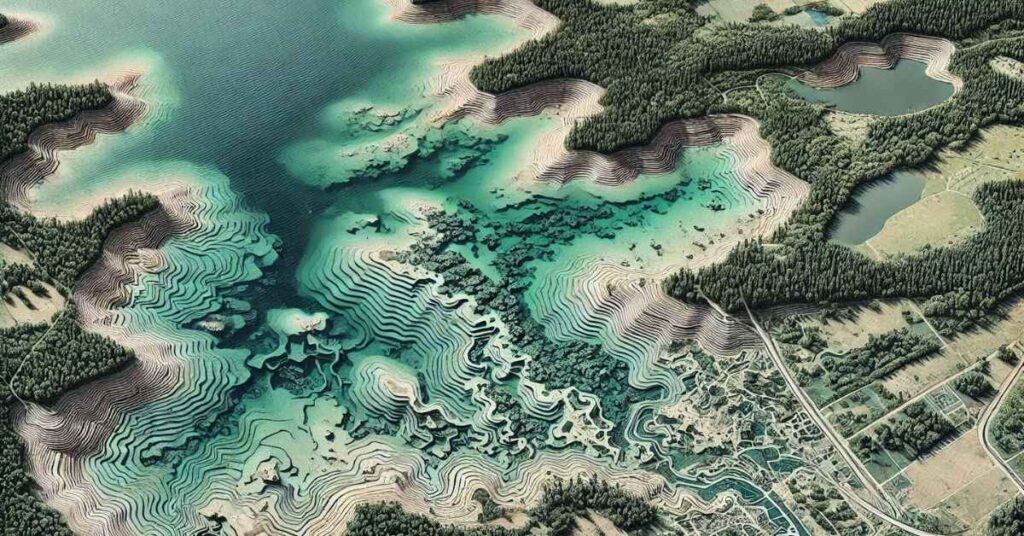
1.1. Geographical Location and Formation
Square Lake is part of the larger glacial landscape of Minnesota, formed thousands of years ago during the last Ice Age. The region surrounding the lake consists of rolling hills, forested areas, and wetlands, typical of the northern temperate biome. The glacial origins of the lake contribute to its depth and its relatively small surface area compared to other lakes in the state.
- Coordinates: Square Lake is located at approximately 45.0756° N latitude and 92.8025° W longitude.
- Elevation: The lake sits at an elevation of around 900 feet above sea level, making it part of a broader watershed system that feeds into larger water bodies in the region.
1.2. Water Sources and Hydrology
Square Lake is a predominantly spring-fed lake, meaning its primary source of water comes from underground springs rather than surface runoff. This characteristic is one of the main reasons for the lake’s crystal-clear water, as groundwater typically contains fewer nutrients and sediments than surface water. Rainfall and limited surface runoff from the surrounding area also contribute to the lake’s water levels.
The outflow of Square Lake drains into other nearby lakes and rivers, making it an integral part of the local watershed. The hydrological balance of the lake is delicately maintained, with water levels fluctuating based on seasonal precipitation and groundwater recharge rates.
2. Water Quality of Square Lake
The pristine water quality of Square Lake is one of its most defining features. The lake consistently ranks among the clearest in Minnesota, with a Secchi disk reading of up to 18 feet on average during summer months. This exceptional clarity is a result of the lake’s low nutrient levels and minimal pollution inputs, making it a haven for aquatic life and human recreation.
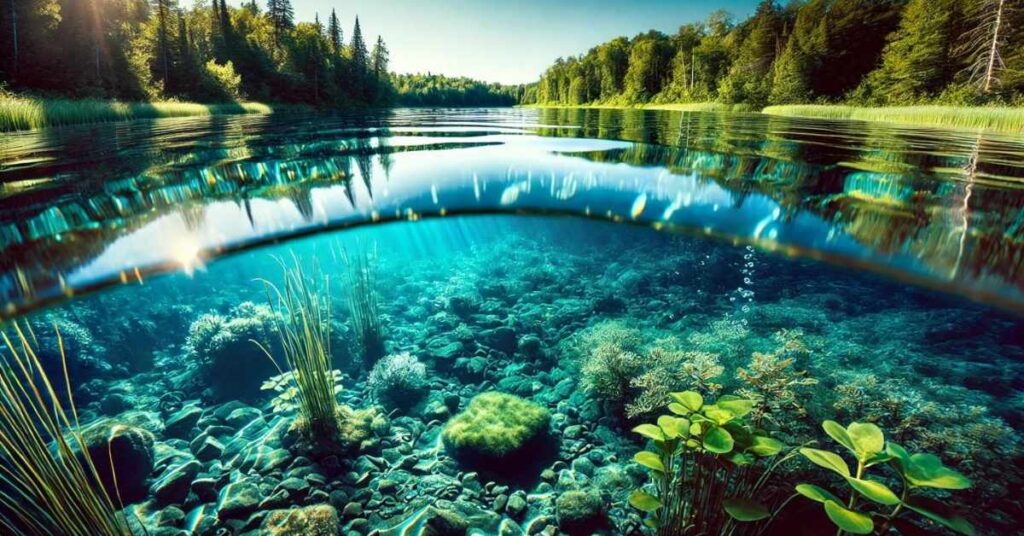
2.1. Nutrient Levels and Eutrophication
One of the critical factors contributing to the lake’s high water quality is its low nutrient load. Unlike many lakes that suffer from eutrophication—a process where excessive nutrients lead to algal blooms and oxygen depletion—Square Lake remains oligotrophic. Oligotrophic lakes are characterized by low concentrations of phosphorus and nitrogen, the primary nutrients responsible for algal growth.
- Phosphorus Concentration: Phosphorus levels in Square Lake average around 10 micrograms per liter, which is significantly lower than many other lakes in the region.
- Nitrogen Concentration: Nitrogen levels are similarly low, contributing to the lake’s ability to support clear water and healthy aquatic ecosystems.
Eutrophication is a concern for many freshwater bodies, particularly those in agricultural regions, but Square Lake’s isolation from intensive farming and urban runoff has helped it maintain its pristine condition. The Minnesota Pollution Control Agency (MPCA) actively monitors nutrient levels in Square Lake to ensure that the lake does not experience degradation over time.
2.2. Clarity and Transparency
The transparency of Square Lake is a direct result of its low nutrient levels and minimal sedimentation. Secchi disk measurements, which are used to gauge water clarity, show readings of 15 to 18 feet on average, with the clearest readings occurring in early summer when nutrient input is at its lowest.
- Water Transparency: Water clarity can reach depths of up to 18 feet during optimal conditions, making Square Lake one of the clearest lakes in Minnesota.
- Algal Bloom Prevention: The lake’s transparency is closely tied to its oligotrophic status, as low nutrient levels prevent the excessive growth of algae, which can cloud the water and reduce oxygen levels.
2.3. Human Impact and Pollution Concerns
Despite its relatively untouched nature, Square Lake is not immune to the pressures of human activity. Residential development around the lake, as well as recreational use, poses a potential threat to water quality. Activities like boating, swimming, and shoreline development can introduce pollutants such as oils, fertilizers, and waste into the water.
The local government and environmental organizations have implemented measures to reduce human impact on Square Lake. These include restrictions on certain types of motorized watercraft, shoreline restoration projects to prevent erosion, and public education campaigns to encourage sustainable recreation practices.
3. Ecological Role of Square Lake
Square Lake plays a vital role in supporting local biodiversity, providing habitat for a variety of aquatic and terrestrial species. The lake’s clear, nutrient-poor waters create a unique environment that supports specialized aquatic organisms, while its surrounding habitats contribute to the overall health of the regional ecosystem.
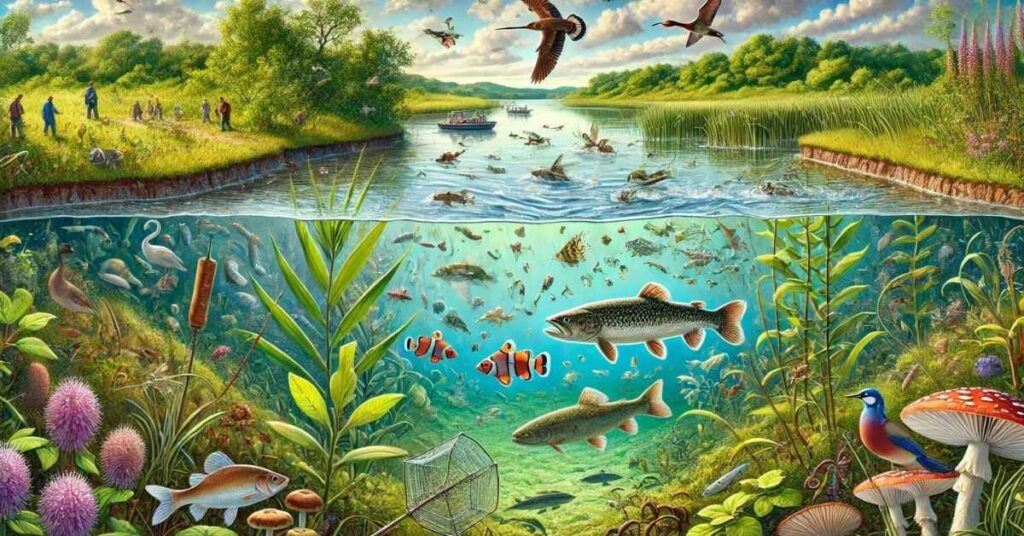
3.1. Aquatic Life
The aquatic ecosystems of Square Lake are characterized by a balance of species adapted to low-nutrient conditions. Fish species, in particular, benefit from the lake’s clean, oxygen-rich water, making it a popular spot for fishing.
- Fish Species: The lake is home to species such as northern pike, largemouth bass, walleye, and bluegill. The low nutrient levels allow for a healthy balance between predator and prey species, maintaining population stability.
- Invertebrates and Zooplankton: Aquatic invertebrates and zooplankton thrive in Square Lake’s clear waters, playing a critical role in the food web by providing a food source for fish and other predators.
3.2. Shoreline and Terrestrial Ecosystems
The shoreline of Square Lake is bordered by mixed forests, wetlands, and grassy areas that provide important habitat for terrestrial species. This area serves as a transition zone between the aquatic and terrestrial ecosystems, supporting a diverse range of species.
- Flora: The vegetation surrounding the lake includes a mix of deciduous and coniferous trees, wetland plants, and grasses. These plants help stabilize the shoreline, reduce erosion, and filter runoff before it enters the lake.
- Fauna: Wildlife such as white-tailed deer, raccoons, waterfowl, and amphibians are commonly found in the areas surrounding Square Lake. The lake’s clean water and undisturbed shores make it a prime habitat for nesting birds, including migratory species.
3.3. Wetlands and Riparian Zones
The wetlands and riparian zones adjacent to Square Lake play a critical role in maintaining the health of the lake’s ecosystem. Wetlands act as natural filters, trapping sediments and pollutants before they can reach the lake. They also provide habitat for a range of species, including amphibians, birds, and insects.
- Wetland Vegetation: Cattails, sedges, and other wetland plants dominate these areas, contributing to water filtration and providing shelter for wildlife.
- Biodiversity Hotspot: These riparian zones are biodiversity hotspots, supporting species that rely on both aquatic and terrestrial environments. Wetlands are particularly important for breeding amphibians, such as frogs and salamanders, which use these areas for reproduction.
4. Climate and Seasonal Changes
Like most lakes in Minnesota, Square Lake experiences significant seasonal variations, which affect both its physical characteristics and its biological activity. The region’s temperate climate results in cold winters and warm summers, with the lake freezing over during the winter months.

4.1. Seasonal Water Temperature Fluctuations
Square Lake’s water temperature varies dramatically throughout the year, influencing the activity of aquatic life and recreational use.
- Summer: During the summer months, water temperatures in the upper layers of the lake can reach as high as 25°C (77°F), providing ideal conditions for swimming, boating, and fishing.
- Winter: In winter, the lake is typically covered with ice, which can be several feet thick. Ice fishing is a popular winter activity, and the lake’s relatively shallow depth allows it to freeze quickly.
- Turnover Events: Like many lakes, Square Lake undergoes seasonal turnover events in the spring and fall. During these periods, the water layers mix, redistributing oxygen and nutrients throughout the lake.
4.2. Ice Cover and Winter Ecology
Winter brings a different ecological dynamic to Square Lake, as ice cover significantly alters the behavior of aquatic species and slows biological processes.
- Oxygen Levels: Oxygen levels can decrease under the ice as decomposition processes consume available oxygen. However, Square Lake’s relatively low nutrient levels mean that winter oxygen depletion is typically not a significant problem.
- Winter Fishing: Ice fishing is a popular activity during the winter months, with anglers targeting species such as northern pike and walleye. The lake’s clear water makes it easier for fish to spot bait, adding an extra challenge for anglers.
5. Human Activities and Recreation
Square Lake is a popular recreational destination, attracting visitors for its clear waters, beautiful surroundings, and outdoor activities. However, these activities must be managed carefully to prevent negative impacts on the lake’s environment.
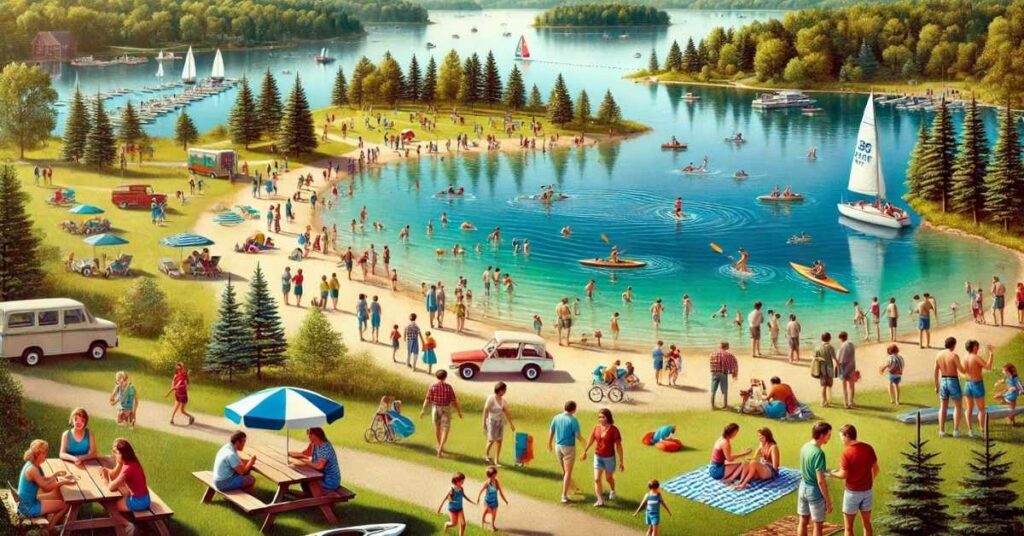
5.1. Recreational Activities
Square Lake offers a variety of recreational opportunities that attract both local residents and visitors. These activities take advantage of the lake’s clear water and natural beauty, but managing human impact on the lake’s ecosystem is critical to maintaining its environmental health.
- Swimming: Square Lake is one of the few lakes in the region with water clarity suitable for swimming and snorkeling. The sandy beaches and designated swimming areas make it a popular spot for families and casual swimmers. Because of its high water quality, swimmers flock to the lake in the warmer months.
- Boating and Kayaking: Non-motorized boating, such as kayaking, paddleboarding, and canoeing, are popular on Square Lake. These activities allow people to explore the lake’s shoreline without causing much disruption to the aquatic environment. Motorized boating is restricted to protect the lake’s clarity and prevent shoreline erosion.
- Fishing: Anglers are drawn to Square Lake year-round, with the lake offering excellent opportunities for catching northern pike, largemouth bass, and walleye. Ice fishing is particularly popular during the winter months, with fish species becoming more accessible as they congregate in deeper areas.
5.2. Conservation Efforts and Environmental Education
Recognizing the ecological importance of Square Lake, various conservation programs and initiatives have been introduced to protect its pristine environment. Local government and environmental organizations collaborate to manage recreational use and educate the public about responsible practices to ensure that the lake remains a viable habitat for future generations.
- Shoreline Protection: One of the major conservation concerns around Square Lake is shoreline erosion caused by human activity. Programs aimed at restoring native vegetation along the shores help prevent erosion and provide habitat for wildlife.
- Water Quality Monitoring: The Minnesota Pollution Control Agency (MPCA) and local conservation groups regularly monitor the lake’s water quality to detect early signs of nutrient pollution or contamination. The implementation of water quality monitoring programs ensures that the lake’s oligotrophic state is preserved.
- Environmental Education Programs: Public awareness campaigns and educational initiatives encourage responsible use of Square Lake. Programs that promote “leave no trace” principles, proper waste disposal, and minimizing the use of fertilizers or chemicals in the lake’s vicinity help prevent pollution and degradation.
5.3. Zoning and Development Controls
With increasing interest in lakeside properties and recreational use, the pressure for residential development around Square Lake has grown. To maintain the balance between human enjoyment and environmental protection, zoning regulations and development controls have been put in place to minimize the environmental impact of housing, infrastructure, and recreational facilities.
- Zoning Regulations: Strict zoning laws restrict the type and extent of development allowed near Square Lake. Residential properties must maintain buffer zones between structures and the lake to prevent runoff and reduce habitat destruction. These regulations help limit impervious surfaces that could lead to increased runoff and pollution.
- Sustainable Development Practices: Developers are encouraged to use sustainable building practices that incorporate low-impact materials, rainwater management systems, and septic solutions that minimize waste discharge into the lake. Efforts are also made to preserve natural vegetation around the lake to reduce erosion and habitat loss.
6. Ecological Challenges Facing Square Lake
Like many freshwater ecosystems, Square Lake faces a variety of environmental challenges, both natural and human-induced. Addressing these challenges is essential for ensuring the long-term sustainability of the lake’s ecosystems.
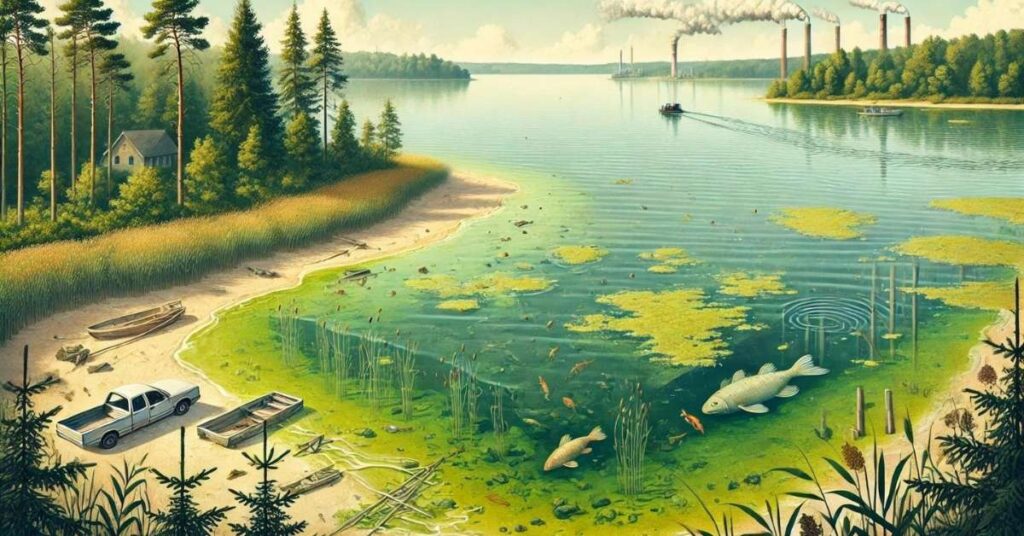
6.1. Invasive Species
One of the biggest threats to Square Lake’s ecosystem is the introduction of invasive species. Non-native plants and animals can significantly disrupt the balance of the lake’s aquatic systems, outcompeting native species and altering habitat dynamics.
- Aquatic Invasive Species (AIS): Invasive plants like Eurasian watermilfoil and curly-leaf pondweed pose a risk to Square Lake’s aquatic environment. These plants can grow rapidly, choking out native vegetation and making it difficult for fish and other aquatic organisms to thrive.
- Zebra Mussels: Zebra mussels, a highly invasive mollusk, are another concern for Square Lake. They attach to hard surfaces, including docks, boats, and even other aquatic species. Zebra mussels can filter significant amounts of water, reducing plankton populations and altering the food web in ways that can harm fish and other aquatic life.
Efforts to prevent the spread of invasive species include mandatory boat inspections at the lake’s public access points and educational campaigns targeting lake users. Boaters and anglers are encouraged to clean their equipment thoroughly before and after use to avoid introducing invasive species into the lake.
6.2. Climate Change and Its Effects
Climate change poses a long-term threat to the environmental stability of Square Lake. Shifts in weather patterns, temperature, and precipitation can influence the lake’s hydrology, biodiversity, and overall ecosystem health.
- Temperature Increases: As global temperatures rise, Square Lake could experience higher surface water temperatures, which may affect the species composition of the lake. Warmer waters could favor species that thrive in higher temperatures, leading to shifts in fish populations and the introduction of new species that may not have been previously present.
- Altered Hydrological Cycles: Climate change could also lead to more erratic precipitation patterns, with potential increases in both droughts and heavy rain events. During drought periods, water levels in Square Lake may drop, while heavy rains could increase runoff and introduce more nutrients and pollutants into the lake.
- Ice Cover Reduction: Warmer winters may reduce the duration and thickness of ice cover on Square Lake. This could alter winter ecology by affecting fish behavior, predator-prey interactions, and recreational opportunities like ice fishing.
6.3. Nutrient Pollution and Runoff
While Square Lake has maintained a relatively oligotrophic status, the potential for nutrient pollution remains a concern, especially with increased human activity around the lake. Even small increases in phosphorus and nitrogen levels could trigger algae blooms, reducing water clarity and oxygen levels.
- Agricultural Runoff: Although agricultural activity near Square Lake is minimal, there is always a risk that nutrient-rich runoff from farms farther afield could eventually make its way into the lake through surface water or groundwater flow.
- Residential Runoff: Runoff from residential areas, including lawn fertilizers, pet waste, and septic system leaks, can also introduce nutrients into the lake. This type of pollution is more difficult to control because it originates from a variety of diffuse sources around the lake.
7. Future of Square Lake: Conservation and Sustainability
The future of Square Lake hinges on balancing human use with the conservation of its unique environmental qualities. Ensuring the sustainability of the lake and its ecosystems will require ongoing efforts to monitor water quality, manage recreational activities, and mitigate the impacts of climate change and invasive species.
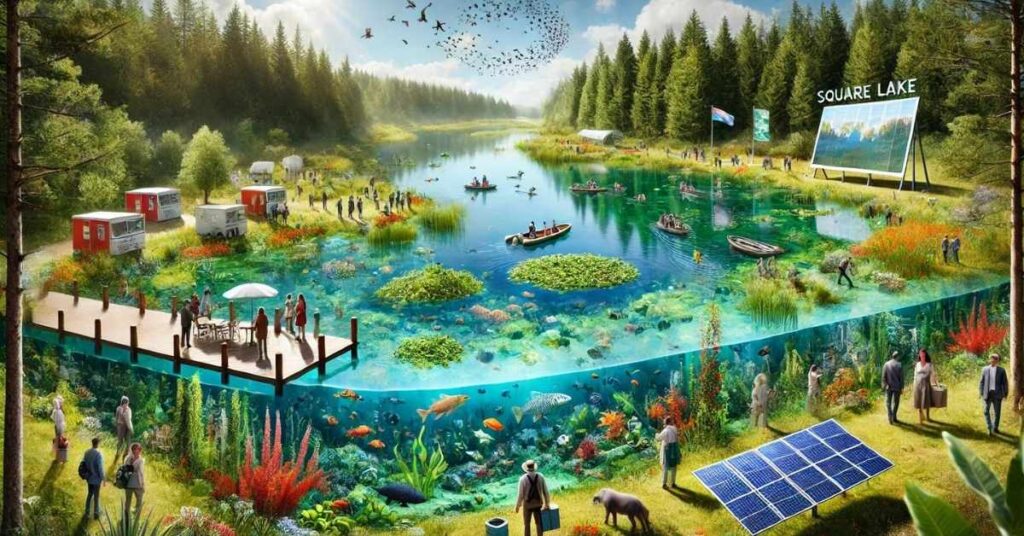
7.1. Ongoing Monitoring and Research
Long-term monitoring of water quality, species populations, and environmental conditions is essential for detecting changes in the lake’s ecosystem. Regular assessments by state agencies and local conservation groups will help identify emerging issues early and develop strategies to address them.
- Citizen Science Initiatives: Involving local residents and visitors in monitoring efforts through citizen science programs can expand the scope of data collection. Volunteers can help track changes in water clarity, temperature, and wildlife populations, contributing valuable information to conservation efforts.
- Collaborative Research: Partnering with academic institutions and environmental organizations can support ongoing research into the lake’s ecological dynamics, offering new insights into the challenges Square Lake may face in the future.
7.2. Sustainable Recreation and Development Practices
Sustainable management of recreational activities and shoreline development will be critical in preserving the ecological integrity of Square Lake. Expanding public education efforts and implementing stricter regulations can help minimize the human impact on the lake.
- Eco-friendly Recreation: Encouraging visitors to use non-motorized boats, practice catch-and-release fishing, and follow proper waste disposal practices will reduce the environmental footprint of recreational activities.
- Green Development Practices: New developments around the lake should prioritize sustainability, incorporating eco-friendly building materials, rain gardens, permeable surfaces, and septic systems that minimize nutrient runoff.
7.3. Climate Adaptation Strategies
As climate change continues to affect freshwater ecosystems, adaptive management strategies will be necessary to protect Square Lake from the impacts of rising temperatures and changing precipitation patterns.
- Shoreline Buffer Zones: Expanding natural buffer zones along the shoreline can help absorb excess runoff and reduce the impact of heavy rain events. Native vegetation will not only stabilize the soil but also filter pollutants before they reach the lake.
- Water Level Management: In the event of prolonged droughts or increased water demand, managing the lake’s water levels will be critical to maintaining its ecological balance. Innovative water conservation techniques, such as rainwater harvesting and controlled groundwater use, may be needed to ensure the lake’s long-term sustainability.
Conclusion: Preserving Square Lake’s Environmental Legacy
Square Lake is a vital environmental asset in Minnesota, offering clear waters, rich biodiversity, and recreational opportunities while maintaining its ecological integrity. As human activities and environmental challenges continue to shape the future of Square Lake, careful management and conservation efforts will be essential in preserving this natural gem for generations to come.
By understanding the lake’s environmental niche—its physical characteristics, biological dynamics, and interactions with human activity—conservationists, policymakers, and the public can work together to protect the lake from threats such as invasive species, nutrient pollution, and climate change. Ensuring the continued health of Square Lake will require an integrated approach that balances human use with environmental stewardship, allowing this unique lake to remain a sanctuary for both people and wildlife.
Read More: The Lightning Struck Tree: Understanding its Impacts On Environment

